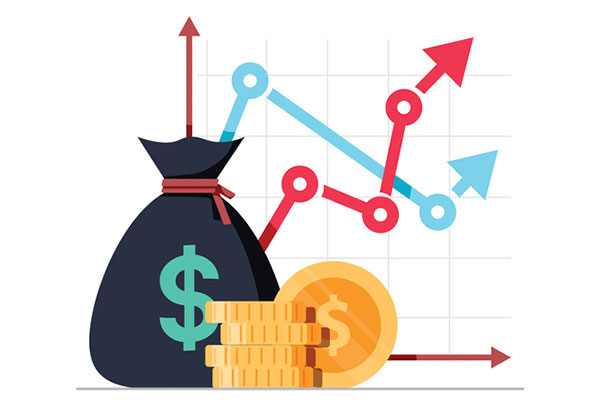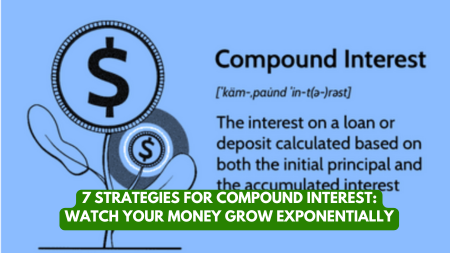No products in the cart.
Stock Market
7 Strategies for Compound Interest: Watch Your Money Grow Exponentially
7 Strategies for Compound Interest: Watch Your Money Grow Exponentially
Compound interest is a powerful financial instrument that can accelerate wealth creation through a snowball effect. Unlike simple interest, which generates returns only on your initial investment, compound interest works by generating interest on both your original principal and the accumulated interest from previous periods. This mathematical phenomenon creates exponential growth that can transform modest savings into substantial wealth over time. For Filipinos looking to secure their financial future, understanding and harnessing the power of compound interest is essential. This article explores seven strategic approaches that can help Filipino investors maximize their returns through the magic of compounding.
Why Compound Interest Matters for Filipinos
In a rapidly developing economy like the Philippines, where financial literacy is still evolving and traditional saving methods remain common, compound interest offers a pathway to financial freedom that many have yet to fully explore. The Philippine financial landscape now provides numerous vehicles for compound growth, from traditional bank products to modern investment platforms. With proper knowledge and application, Filipinos from all income levels can leverage compound interest to build generational wealth and achieve long-term financial goals.
1. Get Started Early: The Time Value of Money
The most critical factor in maximizing compound interest is time. Beginning your investment journey early creates a tremendous advantage that cannot be replicated later in life. This principle, known as the time value of money, works particularly well in the Philippine context, where many young professionals often delay investing until their 30s or 40s.
Consider this compelling example: A 25-year-old Filipino who invests ₱10,000 annually with a modest 5% yearly return will accumulate approximately ₱1.2 million by age 65. In contrast, someone starting at age 35 with the same investment amount and return rate will accumulate only about ₱540,000 – less than half the amount. This dramatic difference illustrates what financial experts call the “eighth wonder of the world” – the power of compound interest over extended periods.
For young Filipinos, even starting with smaller amounts can yield significant results. A college graduate beginning with just ₱2,000 monthly investments will surpass someone who starts a decade later with ₱5,000 monthly contributions, despite investing less money overall.
2. Make Regular, Consistent Investments
Consistency forms the bedrock of successful compound interest strategies. Regular contributions to your investment accounts – whether monthly, quarterly, or annually – provide continuous fuel for the compounding process. This approach, known as peso-cost averaging, offers multiple benefits for Filipino investors:
- It creates financial discipline by establishing a routine for saving and investing
- It reduces the impact of market volatility by spreading investments over time
- It ensures continuous compounding rather than sporadic growth
Setting up automated transfers from your payroll account to investment accounts removes the psychological barriers to consistent investing. Many Philippine banks and investment platforms now offer automatic deduction services that align with typical Filipino pay periods (semi-monthly or monthly). For example, institutions like BDO, BPI, and Security Bank provide scheduled transfer services that make regular investing effortless.
This approach is particularly valuable in the Philippine context, where financial discipline can be challenging due to various cultural expenditures like fiestas, family obligations, and gift-giving traditions. Automated investing helps overcome these potential interruptions to your wealth-building journey.
3. Select High-Yielding Investment Vehicles
The interest rate applied to your investments dramatically affects the compounding process. In the Philippines, various investment vehicles offer different rates of return with corresponding risk levels. To maximize compound interest, consider these options:
High-Yield Savings Accounts: Digital banks like CIMB, ING, and Tonik frequently offer promotional rates between 4-6% annually, significantly higher than traditional savings accounts that typically yield less than 1%.
Time Deposits: Major Philippine banks offer time deposits with slightly higher rates than regular savings accounts, usually between 1-3% depending on the term length.
Government Programs: The Pag-IBIG MP2 Savings Program has historically provided annual returns between 5-7%, while the SSS PESO Fund offers competitive rates with the backing of government security.
Bonds: Both government and corporate bonds can provide annual yields ranging from 3-8% depending on the issuer and duration.
Mutual Funds and UITFs: These professionally managed investment vehicles have historically generated returns between 5-12% annually over long periods, though with higher volatility.
Stocks and Equities: The Philippine Stock Exchange has delivered average annual returns of around 10-12% over extended periods, though with greater fluctuations.
The substantial difference between a 1% and 7% annual return cannot be overstated. On a ₱100,000 investment over 30 years, a 1% return yields approximately ₱135,000, while a 7% return produces over ₱761,000 – more than five times as much.
4. Reinvest Interest and Dividends
The essence of compound interest lies in allowing your earnings to generate their own returns. Rather than withdrawing interest, dividends, or other investment income, reinvesting these earnings accelerates the compounding process significantly.
Many Philippine investment platforms offer automatic reinvestment options:
- Most mutual funds and UITFs provide dividend reinvestment plans (DRIPs)
- Stock brokerage accounts like COL Financial offer options to reinvest dividends into additional shares
- Bond funds typically reinvest interest payments by default
Consider the growth difference: A ₱100,000 investment earning 8% annually with withdrawn interest would grow to only ₱180,000 after 10 years (₱100,000 principal plus ₱80,000 in withdrawn interest). However, the same investment with reinvested interest would grow to approximately ₱215,900 – an additional ₱35,900 simply by allowing your money to compound fully.
For Filipino investors, particularly those supporting extended families, the temptation to withdraw earnings can be strong. Creating separate emergency funds and income accounts can help maintain discipline with your long-term investment accounts.
5. Utilize Tax-Advantaged Accounts
The Philippines offers several investment vehicles with tax advantages that can dramatically enhance compound growth. When investment returns are not diminished by taxation, the compounding effect works more efficiently.
Key tax-advantaged options include:
Pag-IBIG MP2 Savings Program: This voluntary government savings program offers tax-free earnings with historically competitive returns between 5-7% annually.
SSS PESO Fund: The Personal Equity and Savings Option allows members to supplement their regular SSS contributions with additional voluntary contributions that grow tax-free.
PERA (Personal Equity and Retirement Account): Similar to 401(k) plans in the US, these accounts offer tax incentives for retirement savings with a 5% tax credit on contributions up to a certain limit.
These programs demonstrate the Philippine government’s commitment to encouraging long-term savings and investment. For a Filipino investor in the 25% tax bracket, a tax-free 6% return is equivalent to an 8% return in a taxable account – a significant advantage that compounds over decades.
6. Avoid Frequent Withdrawals
Withdrawing funds from compounding accounts disrupts the growth process and significantly reduces long-term returns. This principle is particularly relevant in the Philippine context, where financial emergencies can arise unexpectedly due to healthcare costs, natural disasters, or family obligations.
To illustrate the impact: A ₱500,000 investment growing at 7% annually would reach approximately ₱983,600 after 10 years. However, withdrawing just ₱50,000 in year five reduces the final value to about ₱899,800 – a difference of ₱83,800, or more than 1.5 times the withdrawal amount.
To protect your compounding investments:
- Establish a separate emergency fund covering 6-12 months of expenses before focusing on long-term investments
- Create distinct accounts for different financial goals with various time horizons
- Consider insurance products like health insurance and income protection to avoid liquidating investments during emergencies
Many Filipino financial advisors recommend maintaining liquid emergency funds in high-yield digital banking accounts while keeping long-term investments untouched in separate vehicles with higher compounding potential.
7. Gradually Increase Contributions
As your income grows throughout your career, incrementally increasing your investment contributions can dramatically accelerate wealth building. In the Filipino workplace, where regular salary increases and “13th month pay” are common, systematic contribution increases leverage compound interest to its full potential.
Consider this strategy:
- Increase investment contributions by 1-2% of your salary annually
- Allocate a percentage (perhaps 50%) of bonuses, 13th month pay, or salary increases to investments
- Implement the “save more tomorrow” approach, where you commit in advance to allocate future income increases to investments
For a Filipino professional starting with a ₱30,000 monthly salary and ₱3,000 (10%) monthly investments, increasing contributions by just 1% of salary annually would result in approximately ₱2.1 million additional wealth over 30 years compared to maintaining the initial contribution amount (assuming 6% investment returns and 5% annual salary growth).
Philippine Compound Interest Growth Example
To demonstrate the transformative power of compound interest in a Philippine context, consider this scenario using a ₱50,000 annual investment (approximately ₱4,167 monthly) with a 6% compound annual interest rate:
| Time Horizon | Total Investment | Future Value | Interest Earned |
| 10 years | ₱500,000 | ₱678,146 | ₱178,146 |
| 20 years | ₱1,000,000 | ₱1,828,530 | ₱828,530 |
| 30 years | ₱1,500,000 | ₱3,690,387 | ₱2,190,387 |
| 40 years | ₱2,000,000 | ₱7,094,175 | ₱5,094,175 |
This example vividly illustrates how compound interest transforms modest, consistent investments into substantial wealth over time. Note that after 40 years, the interest earned (₱5,094,175) is more than 2.5 times the total amount invested (₱2,000,000) – demonstrating how compound interest eventually does most of the wealth-building work for you.
Cultural Considerations for Filipino Investors
Understanding the cultural context helps Filipino investors apply compound interest principles more effectively:
Bayanihan Spirit: The collective Filipino value of helping family members can sometimes conflict with long-term investing goals. Setting clear boundaries between emergency assistance and long-term investments helps maintain compounding growth.
Risk Aversion: Many Filipinos prefer tangible assets like real estate over financial instruments. Understanding that compound interest often works best in diversified financial investments can help overcome this cultural preference.
Long-Term Planning: Filipino culture sometimes emphasizes immediate needs over distant goals. Reframing compound investing as a way to better provide for family in the future aligns with cultural values while encouraging long-term thinking.
Conclusion

Harnessing the power of compound interest requires discipline, long-term thinking, and strategic planning – traits that align well with Filipino values of perseverance (tiyaga) and resourcefulness (diskarte). By starting early, investing consistently, selecting high-yield accounts, reinvesting earnings, utilizing tax advantages, avoiding premature withdrawals, and gradually increasing contributions, Filipinos can transform modest savings into significant wealth.
The journey to financial freedom through compound interest isn’t about getting rich quickly, but rather about building wealth steadily and systematically. As the mathematical principle works its magic, small, consistent actions today create exponential results tomorrow – potentially changing not just your financial future, but that of generations to come.
The most important step is simply to begin. Whether you’re starting with ₱1,000 or ₱100,000, the principles of compound interest apply equally. The combination of time, consistency, and the exponential nature of compounding can help Filipinos at all income levels build wealth and achieve their long-term financial goals.
READ MORE RELATED BLOGS!
READ MORE AND SHARE!
TSOK Chronicles: Unleashing Passion, Dedication, and Excellence in 2024
2023 Your Practical Wedding Guide
Investments and Finance Ultimate Guide
If you like this article please share and love my page DIARYNIGRACIA PAGE Questions, suggestions send me at diarynigracia@gmail.com
You may also follow my Instagram account featuring microliterature #microlit. For more of my artworks, visit DIARYNIGRACIA INSTAGRAM


Peace and love to you.